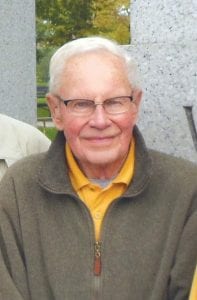Ken Rusk has lived a quiet life on the Gunflint Trail since moving here in the 1970s, working for the U.S. Forest Service and guiding people into his beloved Boundary Waters. Perhaps his love for the peaceful Gunflint area is because of his rocky start in the working world. Rusk is a World War II era veteran, but before he even entered the Armed Forces, he was serving his country as a machinist.
As a young married man with two daughters in 1941, he went to work at the Gisholt Machine Company in Madison, Wisconsin— making turret lathes that were sent overseas to be used in the war effort.
There was an accident in the plant and both of Rusk’s arms and hands were severely burned. He was hospitalized for three months and underwent many skin grafts but still lost a finger on his left hand. Rusk remembers hearing about the Japanese attack on Pearl Harbor while he was in the hospital.
His recovery took a year, but he eventually was able to return to Gisholt, working on a variety of machines. He was eventually transferred to a plant where radar equipment was being built. He remembers that he and his coworkers were housed in a special fireproof building because they used magnesium in their work. Asked if it was difficult working in an area so flammable after his experience, Rusk said simply, “I didn’t think about it.”
He worked there as the war was winding down— he thought. However, at the time of the Battle of the Bulge, Rusk received his draft notice.
He was inducted into the Army Air Corps on August 13, 1945. He was sent to basic training at Fort Worth Air Force Base in Texas. After completing basic training, he was transferred to Geiger Field in Washington State, assigned to the 463rd Army-Air Force. Because of his machine experience, he was made corporal and assigned the role of small arms weapons mechanic, overseeing an armament shop.
He was responsible for inspection and if necessary, repair of arms on the field. He worked on a variety of weapons—pistols, rifles, shotguns, 30- and 50-caliber machine guns. Along with three assistants, Rusk replaced defective parts, fabricating what they needed if it was unavailable, using a drill press, milling machine and lathe. They continuously test fired the weapons to make sure they were in good condition.
And of course, because it was government work, Rusk recalls keeping records of all those inspections and maintenance.
When it came time to get out or re-enlist, Rusk was asked to stay in with the promotion of three grades. The offer was tempting financially but Rusk decided to muster out as a corporal. “It was time to go home,” he said.
Despite playing an important role at Geiger Field, Rusk downplays his military service, noting that he didn’t serve overseas like his brothers did. “I am very proud of my three brothers who also served in the service—Glenn, in the Army in Europe; Clayton, a Marine in the Pacific who was wounded with shrapnel; and Blaine, in the Navy, who was at Pearl Harbor when he was just 17 years old.”
Rusk said Blaine was on the Maryland Battle Wagon and was involved in most of the battles in the Pacific. “They all came home safely, but are deceased now,” said Rusk, noting that was why he was so proud to have participated in the October 9, 2012 Northland Honor Flight to Washington, D.C. to see the World War II Veteran’s Memorial and other historic sites.
“I only wish they could have been with me on the Honor Flight, which was one of the highlights of my life,” said Rusk.




Loading Comments